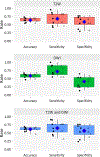MRI assessment of rectal cancer response to neoadjuvant therapy: a multireader study
- PMID: 36814032
- PMCID: PMC10394731
- DOI: 10.1007/s00330-023-09480-9
MRI assessment of rectal cancer response to neoadjuvant therapy: a multireader study
Abstract
Objectives: A watch and wait strategy with the goal of organ preservation is an emerging treatment paradigm for rectal cancer following neoadjuvant treatment. However, the selection of appropriate patients remains a challenge. Most previous efforts to measure the accuracy of MRI in assessing rectal cancer response used a small number of radiologists and did not report variability among them.
Methods: Twelve radiologists from 8 institutions assessed baseline and restaging MRI scans of 39 patients. The participating radiologists were asked to assess MRI features and to categorize the overall response as complete or incomplete. The reference standard was pathological complete response or a sustained clinical response for > 2 years.
Results: We measured the accuracy and described the interobserver variability of interpretation of rectal cancer response between radiologists at different medical centers. Overall accuracy was 64%, with a sensitivity of 65% for detecting complete response and specificity of 63% for detecting residual tumor. Interpretation of the overall response was more accurate than the interpretation of any individual feature. Variability of interpretation was dependent on the patient and imaging feature investigated. In general, variability and accuracy were inversely correlated.
Conclusions: MRI-based evaluation of response at restaging is insufficiently accurate and has substantial variability of interpretation. Although some patients' response to neoadjuvant treatment on MRI may be easily recognizable, as seen by high accuracy and low variability, that is not the case for most patients.
Key points: • The overall accuracy of MRI-based response assessment is low and radiologists differed in their interpretation of key imaging features. • Some patients' scans were interpreted with high accuracy and low variability, suggesting that these patients' pattern of response is easier to interpret. • The most accurate assessments were those of the overall response, which took into consideration both T2W and DWI sequences and the assessment of both the primary tumor and the lymph nodes.
Keywords: MRI; Neoadjuvant treatment; Organ preservation; Rectal cancer; Watch and wait.
© 2023. The Author(s), under exclusive licence to European Society of Radiology.
Figures



References
-
- Maas M, Nelemans PJ, Valentini V et al. (2010) Long-term outcome in patients with a pathological complete response after chemoradiation for rectal cancer: a pooled analysis of individual patient data. Lancet Oncol 11:835–844 - PubMed
-
- Chen TY, Wiltink LM, Nout RA et al. (2015) Bowel function 14 years after preoperative short-course radiotherapy and total mesorectal excision for rectal cancer: report of a multicenter randomized trial. Clin Colorectal Cancer 14:106–114 - PubMed
-
- Maas M, Beets-Tan RG, Lambregts DM et al. (2011) Wait-and-see policy for clinical complete responders after chemoradiation for rectal cancer. J Clin Oncol 29:4633–4640 - PubMed

